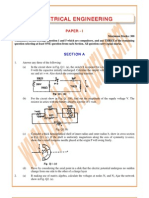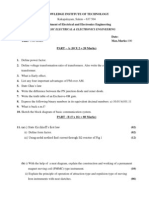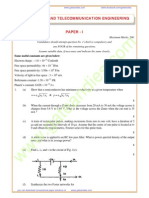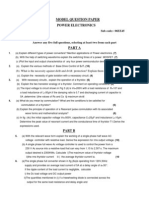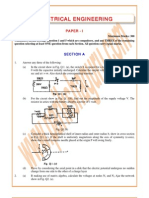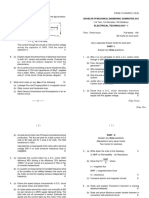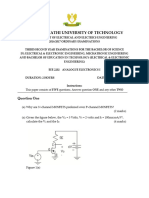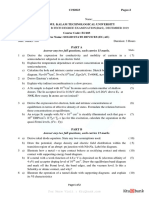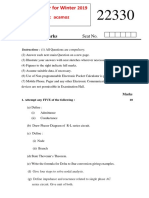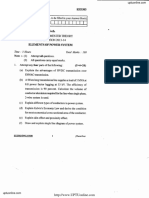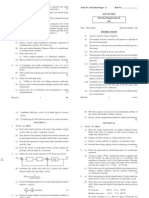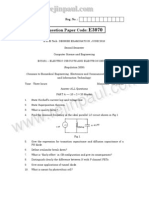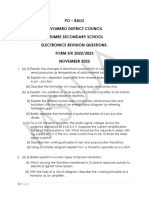IES 1988 Question Paperpdf
IES 1988 Question Paperpdf
Uploaded by
h9emanth4Copyright:
Available Formats
IES 1988 Question Paperpdf
IES 1988 Question Paperpdf
Uploaded by
h9emanth4Original Title
Copyright
Available Formats
Share this document
Did you find this document useful?
Is this content inappropriate?
Copyright:
Available Formats
IES 1988 Question Paperpdf
IES 1988 Question Paperpdf
Uploaded by
h9emanth4Copyright:
Available Formats
P PA AP PE ER R - - I I
Time Allowed: Three Hours Maximum Marks: 200
Candidates should attempt SIX questions, selecting TWO questions from PartA. One from PartB, One
from ParsC and TWO from PartD
The number of marks carried by each question is indicated at the end of the question
Answers must be written in English
P PA AR RT T A A
1. (a) State and explain Reciprocity and Compensation theorems.
8
(b) Given the circuit of Fig. 1, determine the Thevenin equivalent circuit with respect to
terminals A, B and hence find the current flowing through 10O resistor.
12
(c) Write down the equations corresponding to the flow graph shown in Fig. 2. Evaluate the gain
V
6
/V
1
by using Masons rule.
12
2. (a) In the circuit shown in Fig.3, find the initial and final values of the currents i
1
and i
2
(using
initial and final value theorems) when the switch is closed.
I I. .E E. .S S. .- -( (C Co on nv v. .) ) 1 19 98 88 8
E EL LE EC CT TR RI I C CA AL L E EN NG GI I N NE EE ER RI I N NG G
www.estudentzone.com
www.estudentzone.com
Simpo PDF Merge and Split Unregistered Version - http://www.simpopdf.com
16
(b) For the network shown in Fig. 4
(i) determine the Admittance parameters y
11
, y
12
, y
22
6
(ii) find equivalent T-network
6
(iii) determine image impedances.
4
3. (a) Discuss the properties of R-C driving point impedance functions.
12
(b) Synthesize the following function (i) as an Impedance function in the Fosters form (ii) as an
Admittance function in Cauers form:
( )
( )( )
( )( )
2 4
1 3
s s
Z s
s s
+ +
=
+ +
20
PART B
4. (a) Starting from Maxwells equations, obtain the equation for a uniform plane wave in an
unbounded, isotropic, homogeneous medium.
10
(b) Show that in a uniform plane wave motion propagating in z-direction, stored energy density
at each point and each instant is equally divided between electric and magnetic field energy
densities.
12
(c) Evaluate, using Poynting theorem, the power that is conveyed along a coaxial cable carrying
a current I (d.c.) in the inner conductor and sheath forming the return path for the current.
Voltage between inner conductor and the sheath is V. Neglect resistance of the conductors.
www.estudentzone.com
www.estudentzone.com
Simpo PDF Merge and Split Unregistered Version - http://www.simpopdf.com
14
5. (a) Write the Laplaces equation in rectangular, cylindrical and spherical coordinate systems.
9
(b) Find the potential function and electric field intensity for the region between two concentric
circular cylinders whose cross-section is shown in Fig. 5.
12
(c) Define Magnetic Vector Potential. Find Magnetic Vector Potential A due to an infinite plane
current sheet of uniform density K.
15
PART C
6. (a) Explain what is meant by Polarization in a Dielectric. Discuss the types of polarization
mechanisms which may arise in a dielectric.
12
(b) Explain the phenomenon of Piezoelectricity exhibited by some crystals.
8
(c) Mention the properties of Ferroelectric material and explain the phenomenon of
electrostriction.
16
7. (a) What is meant by Hysteresis loss in a ferromagnetic material?
Discuss the factors that govern the magnitude of this loss.
9
(b) Electrical conductivity of a metal conductor can be expressed as
2
e
e
ne
m
t
o =
where n density of free electrons
r relaxation time
e charge on an electron
m
e
mass of an electron
Find, using the above relation, an expression for conductivity of an intrinsic semiconductor in
terms of electron and hole mobilities and the intrinsic carrier density.
12
www.estudentzone.com
www.estudentzone.com
Simpo PDF Merge and Split Unregistered Version - http://www.simpopdf.com
(c) The resistivity of intrinsic germanium at room temperature is equal to 0.47 ohm m. Assuming
electron and hole mobilities of 0.38 and 0.18 rn
2
vol
1
sec
1
respectively, calculate the
intrinsic carrier density.
6
(d) How does the superconductive state differ from normal conducting state? What is the effect
of (i) frequency and (ii) magnetic field on superconductivity?
9
PART D
8. (a) Explain as to what you understand by Primary and Secondary Transducers. Illustrate your
answer with suitable examples.
6
(b) Draw a neat sketch of a Linear Variable Differential Transformer (LVDT) and explain briefly
its principle of working.
12
(c) The output of an LVDT is connected to a 10-V voltmeter through an amplifier whose
amplification factor is 250. An output of 1 m V appears across the terminals of the LVDT
when the core moves through a distance of 0.5 mm. The voltmeter has 100 divisions and
scale can be read to two tenth of a division. Calculate the sensitivity and resolution of the
instrument.
The above arrangement is used in a force transducer for measuring deflection of a cantilever.
The cantilever is deflected through 0.25 mm by a force of one newton. Calculate the
minimum and maximum values of force that can be measured.
14
9. (a) What are the various sources of errors in a.c. bridge circuits? Outline the precautions and
techniques used for reducing such errors.
6
(b) Explain the method of measurement of capacitance and dissipation factor using Schering
bridge. What special features and needed when the bridge is supplied from a high voltage
source?
16
(c) Explain how the relative permittivity of a dielectric material can be determined with the help
of Schering bridge.
10
10. (a) What are the advantage of digital instruments over analogue ones?
5
(b) Explain with the help of functional block diagrams the principle of operation of a Digital
frequency meter.
12
(c) What is meant by Multiplexing in Telemetering system? Describe briefly the method of
Frequency Division multiplexing (FDM) in a telemetering system.
15
www.estudentzone.com
www.estudentzone.com
Simpo PDF Merge and Split Unregistered Version - http://www.simpopdf.com
P PA AP PE ER R - - I I I I
Time Allowed: Three Hours Maximum Marks: 200
Candidates should attempt FIVE questions in all.
choosing at least ONE from each Section
All questions carry equal marks
Answers must be written in English
S SE EC CT TI I O ON N A A
1. (a) What do you understand by string efficiency? Why is it very low for an ordinary insulator
string? Describe briefly the methods used for improving it.
10
(b) What is meant by bundle conductors? Give some typical arrangements of such conductors.
What advantages do they offer over ordinary conductors? Explain briefly.
10
(c) A 3-phase, 125-km long line operating at 50 Hz is supplying a load of 40 MVA at a receiving
end voltage of 110 kV (line-to-line) and a lagging power factor of 0.8. The resistance of the
line is 11 ohms/phase, inductive reactance 38 ohms (line-to-neutral) and capacitive
susceptance 3 x 10
4
mhos (line-to-neutral). Using nominal-pi representation for the line,
calculate
(i) line-to line voltage at the sending end, (ii) the sending-end power factor, and
2. (a) State the meanings of steady-state and transient stability limits and explain why the latter is
lower than the former.
10
(b) Explain the principle of operation of a biased differential relay. What are the reasons for
providing large bias settings in transformer differential relays?
10
(c) Starting with the Gauss theorem, derive an expression for the line-to-neutral capacitance in
microfarads per km of a transmission line having conductors at the corners of an equilateral
triangle. Each side of the triangle in D metres and the radius of each conductor is r metres.
20
P PA AR RT T B B
3. (a) A d.c. shunt motor, whose armature resistance is 0.5 ohm, is to be starred by a controller
which keeps the armature current between the limits of 60 A and 80 A, the supply voltage
being 400 V. Calculate the number and values of the resistance steps. Prove the theory of the
method of calculation you employ.
15
(b) Explain, with the help of neat sketches, how interpoles improve commutation in a d.c.
machine. How are the interpole windings connected in (i) d.c. motors, (ii) d.c. generator?
I I. .E E. .S S. .- -( (C Co on nv v. .) ) 1 19 98 88 8
E EL LE EC CT TR RI I C CA AL L E EN NG GI I N NE EE ER RI I N NG G
www.estudentzone.com
www.estudentzone.com
Simpo PDF Merge and Split Unregistered Version - http://www.simpopdf.com
15
(c) Explain why asynchronous motor does not start by itself.
10
4. (a) Using synchronous-impedance method, determine the voltage regulation of a 2000-volt
single-phase alternator supplying a load current of 100 A at rated voltage and a power factor
of (i) unity, (ii) 0.8 leading, and (iii) 0.707 lagging. The test results available are as follows:
The full- load current of 100 A is produced on short-circuit by a field excitation of 2.5 A, an
e.m.f of 500 V is produced on open circuit by the same excitation, and the armature
resistance is 0.8 ohm.
15
(b) Describe briefly the construction of (i) woundrotor, (ii) deep-bar and (iii) double-cage type
induction motors and explain how in each case a high starting torque is obtained
15
(c) Using double-revolving-field theory, develop an equivalent circuit for single-phase induction
motor.
10
P PA AR RT T C C
5. (a) Sketch the polar (Nyquist) plot on a plain paper for the following transfer function:
( )
( )( )
10
1 1 0.5
G s
s s s
=
+ +
15
(b) Sketch the Bode plots in magnitude and phase versus frequency on a plain paper for the
following transfer function:
( )
( )
( )( )
100 1 0.1
1 0.2 1 0.5
s
G s
s s s
+
=
+ +
15
(c) Using Rouths criterion of stability, determine the range of K for which the system shown in
figure 1 will remain stable.
10
6. (a) Explain the meaning and significance of phase and gain margins of a control system. How
will you obtain the values of these margins from (i) polar plot, and (ii) Bode plots? Illustrate
by giving plots for stable and unstable systems separately.
20
(b) Obtain the state transition matrix of the system represented by the following state equations
and, using the same, determine the time response for t>0
www.estudentzone.com
www.estudentzone.com
Simpo PDF Merge and Split Unregistered Version - http://www.simpopdf.com
| |
1 1
2 2
0 1 0
2 3 1
x x
r
x x
( ( ( (
= +
( ( ( (
The initial conditions are X
1
(0) =1 and x
2
(0) =1 and the input r(t) is a unit step function at
t=0.
20
P PA AR RT T D D
7. (a) Describe, with the help of a block schematic, the principle and working of a modulo-5
counter using flip-flops along with appropriate feedback.
10
(b) Prove that the circuit shown in figure 2 has an outpute
2
given by
2 1
2
e e dt
RC
=
}
if the operational amplifiers an ideal one.
10
(c) Discuss, with the help of a circuit example, the purpose of providing (i) negative feedback,
(ii) positive feedback in amplifiers
10
(d) An average-responding electronic voltmeter has its scale calibrated to indicate correctly the
r.m.s. value of sinusoidal voltages. Calculate the error in its reading if the instrument is used
for measuring value of asymmetrical triangular-wave voltage.
10
8. (a) Prove mathematically that a sine-wave carrier amplitude-modulated by a sinusoidal signal
has three frequency components. Identify the frequencies and amplitudes of these
components in terms of those of the carrier and modulating signal.
10
(b) Giving circuit diagram of an FM detector, describe its operation.
10
(c) What is meant by single-side-band transmission? Comment on its merits and demerits
relative to double-side-band transmission.
10
(d) Write a note of about 250 words on the use of open wires, coaxial cable, microwaves,
waveguides and optical Mire as communication media.
10
www.estudentzone.com
www.estudentzone.com
Simpo PDF Merge and Split Unregistered Version - http://www.simpopdf.com
P PA AR RT T E E
9. (a) Bring out the difference between FUNCTION sub-programme and SUBROUTINE sub-
programme with the help of an example.
10
(b) Identify the errors in the following FORTRAN statements and suggest correction:
10
(i) REAL ITEM, KIT, MASS, INTEGER, BETA.SIGMA
(ii) DO 200 VALUE =0.1, 1.5, 0.2
(iii) IF (PQ)/(R+S) 10,20,30
(iv) GO TO(0,20,50), NODE
(c) Draw a flow chart and write an efficient FORTRAN programme to find the inverse of a
given matrix.
20
10. (a) Draw a functional block diagram of digital computer and explain briefly the role of each unit
therein.
15
(b) Write a programme in FORTRAN language using only logical IF statements and
unconditional Go To where necessary to sum the series
( )
1
1
5 1
n
k
sum
k
=
=
+
Use format-free INPUT/OUTPUT statements to input n and output sum.
15
(c) Translate the following mathematical expressions into FORTRAN statements. Use common
pre-defined functions for parts (iii) and (iv):
10
(i)
7.9
p q
x a
r
+ | |
=
|
\ .
(ii)
5/7 7
y s t
=
(iii)
10
sin| | 1.8log z a b ab = + +
(iv)
2 2 bc
w ae p q
= + +
www.estudentzone.com
www.estudentzone.com
Simpo PDF Merge and Split Unregistered Version - http://www.simpopdf.com
You might also like
- Ese 88Document8 pagesEse 88Prasanna KumarNo ratings yet
- I Es Conventional Paper Electrical 1987Document6 pagesI Es Conventional Paper Electrical 1987Alind DubeyNo ratings yet
- IES-CONV-Electrical Engineering 1994 PDFDocument9 pagesIES-CONV-Electrical Engineering 1994 PDFvineethkbNo ratings yet
- EDC Question-Papers Complete SetDocument13 pagesEDC Question-Papers Complete Setselvi04120% (1)
- IES CONV Electronic& Comm. 1980Document6 pagesIES CONV Electronic& Comm. 1980Sohil VohraNo ratings yet
- Civil Services - Electrical Main Paper I & II - 1992-2012 - 7.6MBDocument253 pagesCivil Services - Electrical Main Paper I & II - 1992-2012 - 7.6MBAnika DixitNo ratings yet
- Basic Electrical & Electronics Engineering (6 Yrs FRM Jan 02)Document23 pagesBasic Electrical & Electronics Engineering (6 Yrs FRM Jan 02)Jay PandyaNo ratings yet
- 3rd SemDocument13 pages3rd SemKiran KumarNo ratings yet
- Assignment BEE CompleteDocument5 pagesAssignment BEE CompleteHarshit YadavNo ratings yet
- 2018 Dec. EC203-E - Ktu QbankDocument2 pages2018 Dec. EC203-E - Ktu QbankBLESSEN BABYNo ratings yet
- Electric Circuits and Electron Devices Unit I Circuit Analysis Techniques Part-ADocument8 pagesElectric Circuits and Electron Devices Unit I Circuit Analysis Techniques Part-ASalai Kishwar JahanNo ratings yet
- 1st Year Que NewDocument3 pages1st Year Que Newbalusasi_skgNo ratings yet
- Btme 103 Basic Electrical and Electronics EngineeringDocument4 pagesBtme 103 Basic Electrical and Electronics Engineeringsheljanmathew2001No ratings yet
- IES CONV Electronic Comm. 1998Document9 pagesIES CONV Electronic Comm. 1998gateandiesNo ratings yet
- IES Conventional Electrical Engineering 2012Document28 pagesIES Conventional Electrical Engineering 2012Srujan BobbyNo ratings yet
- EE301 Power Generation, Transmission and Protection, December 2017 PDFDocument2 pagesEE301 Power Generation, Transmission and Protection, December 2017 PDFAfsal Abdul KarimNo ratings yet
- 3453Document7 pages3453Bnr GoudNo ratings yet
- Model Question Paper Power Electronics: Sub code:-06EE45Document3 pagesModel Question Paper Power Electronics: Sub code:-06EE45GuruprasadNo ratings yet
- Ge2151 Basic Electrical and Electronics EngineeringDocument4 pagesGe2151 Basic Electrical and Electronics EngineeringNithin PurandharNo ratings yet
- Civil Service - Electrical Engineering Main Paper I & II - 1992 - 2007Document147 pagesCivil Service - Electrical Engineering Main Paper I & II - 1992 - 2007venki3236No ratings yet
- Civil Service - Electrical Engineering Main Paper I & II - 1992 - 2007Document147 pagesCivil Service - Electrical Engineering Main Paper I & II - 1992 - 2007venki3236No ratings yet
- Civil Service - Electrical Engineering Main Paper I & II - 1992 - 2007Document147 pagesCivil Service - Electrical Engineering Main Paper I & II - 1992 - 2007venki3236No ratings yet
- May 2010 SupDocument8 pagesMay 2010 SupViswa ChaitanyaNo ratings yet
- 2012 Basic Electrical Engineering: Name Roll No. Invigilator's SignatureDocument7 pages2012 Basic Electrical Engineering: Name Roll No. Invigilator's SignatureKailas P NairNo ratings yet
- Bee-Ug11t2104-1104-Dec 2015Document2 pagesBee-Ug11t2104-1104-Dec 2015Anshuman SharmaNo ratings yet
- Electric Technology - IDocument2 pagesElectric Technology - Ianon_463330020No ratings yet
- IES Conventional Electronics 2013Document32 pagesIES Conventional Electronics 2013Debi Prasad DashNo ratings yet
- Ee 501 SeriesDocument5 pagesEe 501 SeriesFLOWERNo ratings yet
- II B. Tech I Semester, Regular Examinations, Nov - 2012 Electronic Devices and CircuitsDocument4 pagesII B. Tech I Semester, Regular Examinations, Nov - 2012 Electronic Devices and CircuitsViswa ChaitanyaNo ratings yet
- Anna University Microwave Question PapersDocument9 pagesAnna University Microwave Question PapersDeepak100% (2)
- Beem Uni Que PDFDocument14 pagesBeem Uni Que PDFPragna SidhireddyNo ratings yet
- KTU EDC Previous Question PapersDocument12 pagesKTU EDC Previous Question PapersVarun DevNo ratings yet
- PTEE7304 April-2014Document2 pagesPTEE7304 April-2014imman46920No ratings yet
- FEE Model 2Document2 pagesFEE Model 2amangamingofficial2020No ratings yet
- EEE 2202 ANALOGUE ELECTRONICS I - July17 - ExamDocument5 pagesEEE 2202 ANALOGUE ELECTRONICS I - July17 - Exameric wahomeNo ratings yet
- C C192023 Pages:2: Answer Any Two Full Questions, Each Carries 15 MarksDocument2 pagesC C192023 Pages:2: Answer Any Two Full Questions, Each Carries 15 MarksFayaz aliNo ratings yet
- 2020-10-30SupplementaryEC203EC203-I - Ktu QbankDocument2 pages2020-10-30SupplementaryEC203EC203-I - Ktu QbankFayaz aliNo ratings yet
- IES CONV Electronic Comm. 2000Document11 pagesIES CONV Electronic Comm. 2000gateandiesNo ratings yet
- Eci Guessing PaperDocument5 pagesEci Guessing Paperdinesh majumdarNo ratings yet
- Conventional Paper-II-2011 Part-1ADocument6 pagesConventional Paper-II-2011 Part-1ASoumyabrataPatraNo ratings yet
- T127 - Question Bank - Basic Electrical EngineeringDocument6 pagesT127 - Question Bank - Basic Electrical Engineeringharish babu aluruNo ratings yet
- B.Sc. (Aviation SC.) (I Sem.)Document3 pagesB.Sc. (Aviation SC.) (I Sem.)Vipan Sharma100% (1)
- Set No. 1: Cosφ Cosφ.Cos (φ−β) wL RDocument8 pagesSet No. 1: Cosφ Cosφ.Cos (φ−β) wL RViswa ChaitanyaNo ratings yet
- Graph Sheets May Be Supplied On Demand: Page 1 of 2Document2 pagesGraph Sheets May Be Supplied On Demand: Page 1 of 2sarang acNo ratings yet
- Eee-503 Elements of Power System 2013-14Document3 pagesEee-503 Elements of Power System 2013-14Devesh RaiNo ratings yet
- Elctengg Ii Kas12Document2 pagesElctengg Ii Kas12Asif ChoudharyNo ratings yet
- Uace Physics Paper 2014Document5 pagesUace Physics Paper 2014jn257673No ratings yet
- I 9817668 Electrical 1998Document10 pagesI 9817668 Electrical 1998gajjelasuresh1978No ratings yet
- Question Paper Code:: Reg. No.Document0 pagesQuestion Paper Code:: Reg. No.Bala SubramanianNo ratings yet
- Electronics Revision Questions - 100741Document15 pagesElectronics Revision Questions - 100741saidohamimNo ratings yet
- Answer Any Two Full Questions, Each Carries 15 Marks.: Reg No.: - NameDocument2 pagesAnswer Any Two Full Questions, Each Carries 15 Marks.: Reg No.: - Namesheena mNo ratings yet
- EC6701 RFM Question BankDocument9 pagesEC6701 RFM Question BanklakshmiNo ratings yet
- 2012 Basic Electrical Engineering: CS/B.TECH (OLD) /SEM-2/EE-201/2012Document7 pages2012 Basic Electrical Engineering: CS/B.TECH (OLD) /SEM-2/EE-201/2012abhrajitsahaNo ratings yet
- Bee Model Question Paper-2Document3 pagesBee Model Question Paper-2Emmanuel JosephNo ratings yet
- Power System Transient Analysis: Theory and Practice using Simulation Programs (ATP-EMTP)From EverandPower System Transient Analysis: Theory and Practice using Simulation Programs (ATP-EMTP)No ratings yet
- Organic Light-Emitting Transistors: Towards the Next Generation Display TechnologyFrom EverandOrganic Light-Emitting Transistors: Towards the Next Generation Display TechnologyNo ratings yet
- Foundations of Electromagnetic Compatibility: with Practical ApplicationsFrom EverandFoundations of Electromagnetic Compatibility: with Practical ApplicationsNo ratings yet
- English 3rd Class NSM VasuDocument6 pagesEnglish 3rd Class NSM Vasuh9emanth4No ratings yet
- The Jackal and The DrumDocument1 pageThe Jackal and The Drumh9emanth4No ratings yet
- Mini Project On TransformersDocument34 pagesMini Project On Transformersh9emanth4100% (3)
- The Monkey and The WedgeDocument1 pageThe Monkey and The Wedgeh9emanth4No ratings yet
- ITC ImportantDocument4 pagesITC Importanth9emanth4No ratings yet
- ITC ImportantDocument4 pagesITC Importanth9emanth4No ratings yet
- Non Linear Wave ShapingDocument4 pagesNon Linear Wave Shapingh9emanth4No ratings yet
- rip.x264.YIFY English SubtitlesDocument62 pagesrip.x264.YIFY English Subtitlesh9emanth4No ratings yet
- Rip x264 YIFYDocument78 pagesRip x264 YIFYh9emanth40% (1)
- The Story of My Experiments With Truth PDFDocument268 pagesThe Story of My Experiments With Truth PDFh9emanth4100% (1)
- Andhra University AEC Previous Question PapersDocument8 pagesAndhra University AEC Previous Question Papersh9emanth4No ratings yet
- ECE Andhra University SyllabusDocument91 pagesECE Andhra University Syllabush9emanth4No ratings yet
- Design and Analysis Artificial Intelligence (AI) Research For Power Supply - Power Electronics Expert System (PEES)Document7 pagesDesign and Analysis Artificial Intelligence (AI) Research For Power Supply - Power Electronics Expert System (PEES)Jandfor Tansfg ErrottNo ratings yet
- Ece 6 TH Student HandbookDocument43 pagesEce 6 TH Student HandbookDaljit SinghNo ratings yet
- SYSC3600 F12 HandoutDocument5 pagesSYSC3600 F12 HandoutKai JunjieNo ratings yet
- Matlab Aided Control System Design - ConventionalDocument36 pagesMatlab Aided Control System Design - ConventionalGaacksonNo ratings yet
- Unit-4-1 PPT CSDocument78 pagesUnit-4-1 PPT CS20R25A0420 KONDAMUDI VAMSI ANURAGNo ratings yet
- Control System Question BankDocument12 pagesControl System Question BankKarthik NagarajanNo ratings yet
- Control System Engineering - IDocument212 pagesControl System Engineering - IAjit Kumar Kisku100% (1)
- Passivation of Current-Controlled Grid-Connected VSCs Using Passivity IndicesDocument10 pagesPassivation of Current-Controlled Grid-Connected VSCs Using Passivity IndicesEletricaNo ratings yet
- Demystifying Pole Zero DoubletsDocument11 pagesDemystifying Pole Zero Doubletsr0ssumNo ratings yet
- Electronic ReadingDocument18 pagesElectronic Readinggggguccigang123564No ratings yet
- Loop ShapingDocument182 pagesLoop Shapingtasos7639No ratings yet
- Cs Winter 21 GtuDocument3 pagesCs Winter 21 GtuSandeep kumarNo ratings yet
- Standup and Stabilization of The Inverted Pendulum: Massachusetts Institute of TechnologyDocument62 pagesStandup and Stabilization of The Inverted Pendulum: Massachusetts Institute of TechnologyNguyen Thanh KhuongNo ratings yet
- Controls PDFDocument181 pagesControls PDFAlvin Abustan JrNo ratings yet
- Lab ManualDocument41 pagesLab ManualS. SUDHARSAN BE. EEENo ratings yet
- The Flux-Based Sensorless Field-Oriented Control of Permanent Magnet Synchronous Motors Without Integrational DriftDocument22 pagesThe Flux-Based Sensorless Field-Oriented Control of Permanent Magnet Synchronous Motors Without Integrational Driftashebir berhanuNo ratings yet
- Analog & Digital VLSI Design Practice QuestionsDocument24 pagesAnalog & Digital VLSI Design Practice QuestionsAbhinav MishraNo ratings yet
- 5905 19033 1 PBDocument5 pages5905 19033 1 PBalakhibNo ratings yet
- Aam PDFDocument8 pagesAam PDF21F018 - HARIPRASAD MNo ratings yet
- Analysis of Transient Stability in Synchronous GenDocument6 pagesAnalysis of Transient Stability in Synchronous Genmohamedfadda2244No ratings yet
- Cascade Control of A Continuous Stirred Tank Reactor (CSTR) : October 2013Document9 pagesCascade Control of A Continuous Stirred Tank Reactor (CSTR) : October 2013Riicaardo EspinnozaNo ratings yet
- Course Description (MESB323) - PremDocument10 pagesCourse Description (MESB323) - PremDanielRaoNo ratings yet
- Bode PlotDocument19 pagesBode PlotyacobaschalewNo ratings yet
- MSC Aerospace Delft Track Control and SystemsDocument51 pagesMSC Aerospace Delft Track Control and SystemsShashank AminNo ratings yet
- Coeg 401 Past QuestionsDocument52 pagesCoeg 401 Past QuestionsPUSPA JOSHINo ratings yet
- Analog & Digital VLSI Design Analog Assignment: 1. ObjectiveDocument37 pagesAnalog & Digital VLSI Design Analog Assignment: 1. ObjectivewrkahlcNo ratings yet
- B. Tech. - Mechatronics - Scheme+SyllabusDocument48 pagesB. Tech. - Mechatronics - Scheme+SyllabusAkshet PatelNo ratings yet
- Printable Collection of Bode Plot Web PagesDocument48 pagesPrintable Collection of Bode Plot Web PagesThan HtetNo ratings yet
- L22 Guideline SISOToolDocument5 pagesL22 Guideline SISOToolMv IrinelNo ratings yet
- An Innovative Pick and Place Robotic Arm System Using An Atmega328 MicrocontrollerDocument14 pagesAn Innovative Pick and Place Robotic Arm System Using An Atmega328 MicrocontrollerEngr. Najeem Olawale AdelakunNo ratings yet






